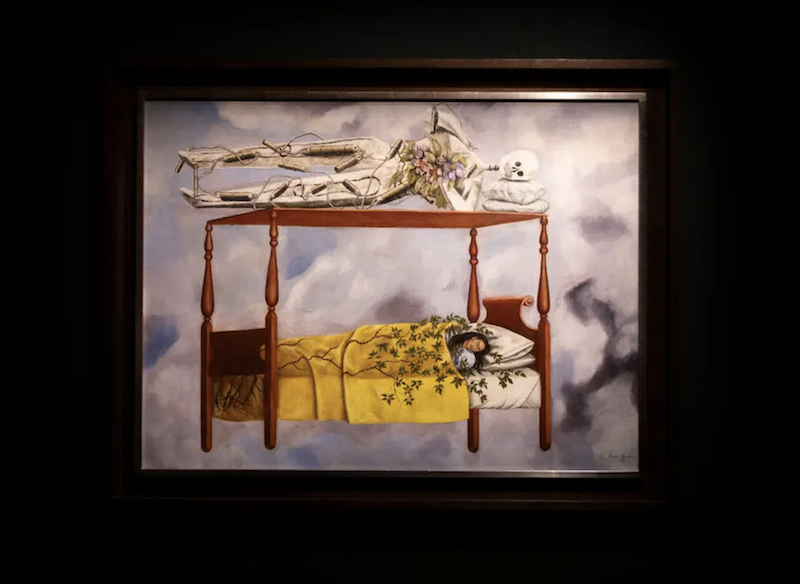
Japan's "Jingjiatang Bunko" is famous for its collection of Chinese and Japanese ancient books; "Eternal Green Bunko" has a collection of many national treasures. The Tokipansan Bunko (founded by industrialist Tsutsuji Sugawara in 1943), which was established relatively late, mainly collects ink marks of Zen monks, Chinese and Japanese paintings, Chinese ceramics, and portraits of gods. There are 2 Japanese national treasures, 23 important cultural properties and 18 important works of art. At present, most of the collections of the Tokipanyama Bunko are stored in the Tokyo National Museum, Kyushu National Museum, etc., in order to maximize the display and research value of the collections.
The Paper learned that on the occasion of the 80th anniversary of the founding of the Tokipansan Bunko, the Tokyo National Museum recently launched a special exhibition "Famous Treasures of the Tokipansan Bunko", displaying a total of 83 pieces (sets) of the library's collections, including "Zen Monk's Ink" and "Chinese Celadon" Among them are the ink stains of the Zen monk Jianmen Miaoshen and Wuzhun Shifan in the Southern Song Dynasty, the celadon bamboo shoot-shaped vase with extremely pure pink and blue color, and the rare "beige celadon" from Hangzhou official kiln in the Southern Song Dynasty. Although these cultural relics immigrated to Japan from China Silent for thousands of years, but with inherent elegance and tranquility.
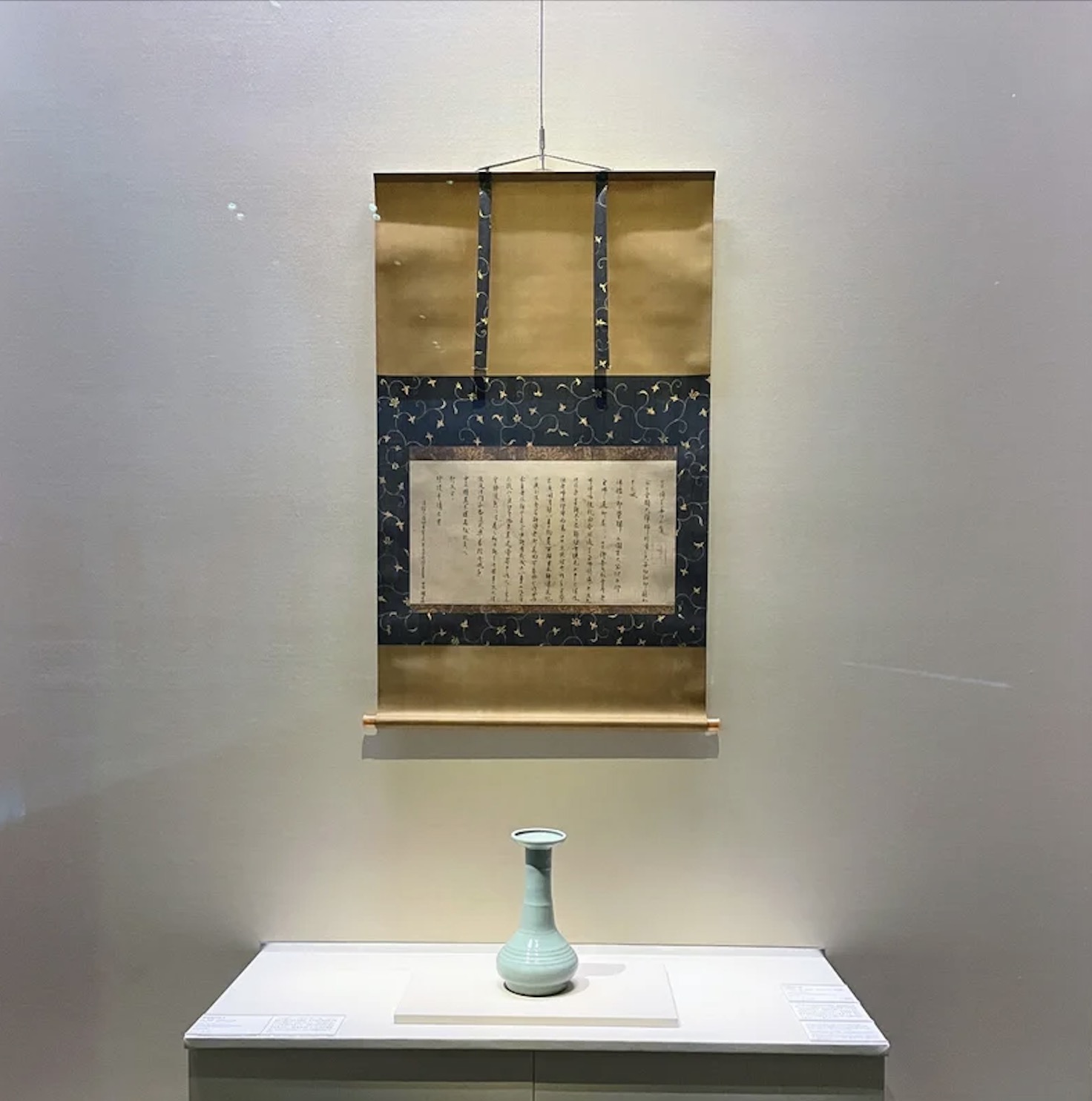
Exhibition site, Southern Song Dynasty monk Jianmen Miaoshen's calligraphy and Longquan kiln's "celadon bamboo shoot vase"
The exhibition begins with two pieces of calligraphy and porcelain from the Southern Song Dynasty in China. The calligraphy work is a letter written by Jianmen Miaoshen, a monk in the Southern Song Dynasty, in the ninth year of Chunyou (1249) to the founder of Tofuku Temple in Japan, Shengyi Guoshi. Before his death, one of the most outstanding Zen monks in the Southern Song Dynasty entrusted him with publishing Buddhist classics; he was in dialogue with a "celadon bamboo shoot-shaped vase" from China's Longquan kiln, showing an extremely pure pink-blue color.

Kenmon Myobumi, "Wan Chido of the Holy One National Teacher", 1249, ink script on paper, 29.6cm×55.7cm, Important Cultural Property of Japan
This group of cultural relics represents two important areas of Tokipanyama Bunko: "Zen Monk's Ink Mark" and "Chinese Celadon". Although they have been silent for thousands of years, they are inherently elegant and quiet.
Thereafter, the exhibition hall is roughly divided into left and right sides. The exhibition hall on the right displays Zen ink, Chinese ceramics and lacquerware, and the exhibition hall on the left focuses on ancient Chinese calligraphy and painting, as well as the influence of Chinese Zen on Japanese calligraphy and painting. Most of the exhibited works come from the Song and Yuan Dynasties of China and the Japanese Middle Ages. These include 2 Japanese national treasures and 21 important cultural properties of Japan. Important exhibits include the "Jasmine Picture" painted by Zhao Chang, the "Yi Yuanji Scroll Postscript" by Feng Zizhen, a literati of the Yuan Dynasty, the ink marks of Chinese Zen monks such as Qing Zhuo Zheng Cheng, Wu Zhun Shi Fan, and Zhong Feng Ming Ben, as well as Longquan kiln celadon Phoenix ear vase, Southern Song Dynasty official kiln beige celadon vase, etc. The exhibition is divided into two phases, and some exhibits will be replaced.

exhibition site
80 years of construction of the Tokiwayama Library
The collection of the Tokiwayama Bunko originates from the industrialist Sugawara Tsutsui (1894-1981, served from 1954 to 1981), who is famous for the construction of the Kamakura-Enoshima Electric Railway and the Kamakurayama residential area. His collection began in 1943, the year the Tokipanyama Bunko was founded. The collection of works of art in the library has attracted many researchers and has gradually become a place for academic exchanges. In 1954, Tsutsuji Sugawara retired from the business world and turned his focus to public welfare, displaying his collection at his residence in Tokiwayama, Kamakura.
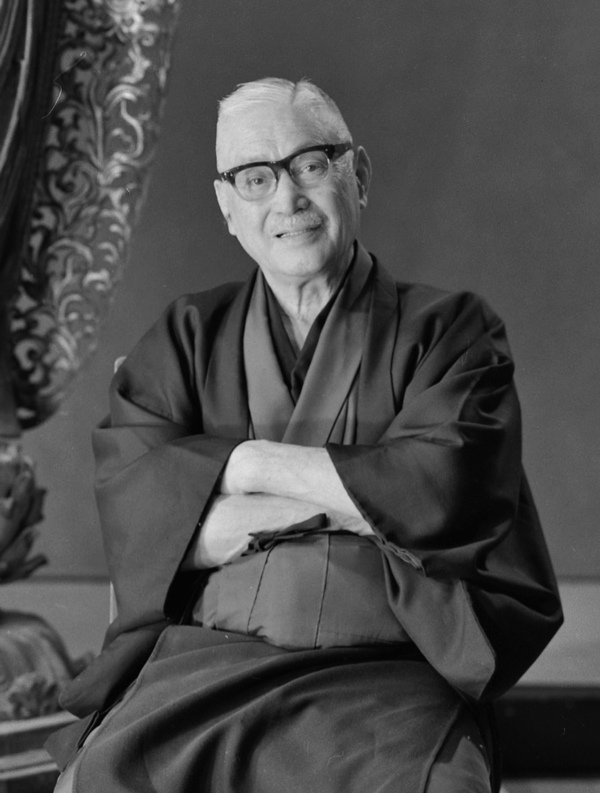
Japanese industrialist Sugawara Tsuji
Tongji's collection began with Zen monk ink marks, as well as Chinese Song and Yuan period paintings and Muromachi period Japanese paintings. His eldest son, Hisao Sugawara (1923-2008, served from 1981 to 1995), the second acting chairman, further expanded the collection, especially dedicated to popularizing the incomprehensible Zen monk's ink; the second son of Tongji, the third acting chairman Haruo Nagasugawara (1930-2019, served from 1995 to 2019) established a collection system of handicrafts including Chinese ceramics and lacquerware, and enjoyed a reputation in Japan.
Looking back on the collection history of 80 years, the biggest feature of Tokipanshan Bunko is the combination of collection and study. Tsutsuji Sugawara was able to build a high-quality collection in part because of his constant learning. In fact, when he first started collecting, Sugawara Tsuji had no knowledge of art, but he purchased about a hundred hanging scrolls at one time, most of which proved to be unsuitable for collection.
Nevertheless, he did not give up because of disappointment, but learned from scratch, especially under the guidance of the young researcher Takaaki Matsushita (1909-1980). Cultivate an eye for appreciating artworks, which in turn promotes high-quality collections. Over time, Mount Tokiwa in Kamakura became a gathering place for scholars and students.
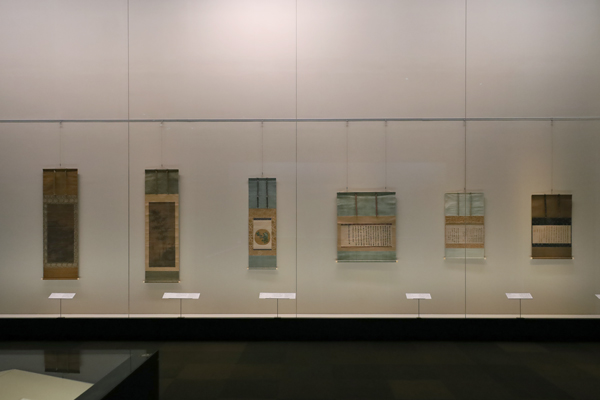
exhibition site
The collection and learning atmosphere with works as the core of research has also been inherited by future generations. The third acting chairman, Haruo Sugawara, developed a strong interest in Chinese celadon. He learned from ceramic scholar Raku Hasebe (born in 1928) and established the "Chinese Ceramics Research Association" to promote the research and collection of Chinese ceramics. At present, the China Ceramic Research Association has published its achievements through the publication of its journal, and made its collections and research public in the form of exhibitions.

Celadon incense burner with appliqués, Southern Song Dynasty, Longquan kiln, 13th century, height 9.2cm, diameter 14.2cm
Collections from the Tokiwayama Bunko have been exhibited in exhibitions such as "Japan's Favorite Official Kiln Celadon" held by the Tokyo National Museum in 2014 and "The Birth and Development of Early White Porcelain White Porcelain" in 2019.
Among them, "Japanese Official Kiln Celadon" is a collection of precious celadon from the Northern Song Dynasty Ru Kiln and the Southern Song Dynasty Official Kiln in the National Palace Museum in Taipei, China. Correspondingly, Japan exhibited official kiln porcelain collected by the Tokyo National Museum, Tokiwayama Library, Art and Science Foundation, etc., showing Japan's perspective on appraisal and collection, as well as the history of research.
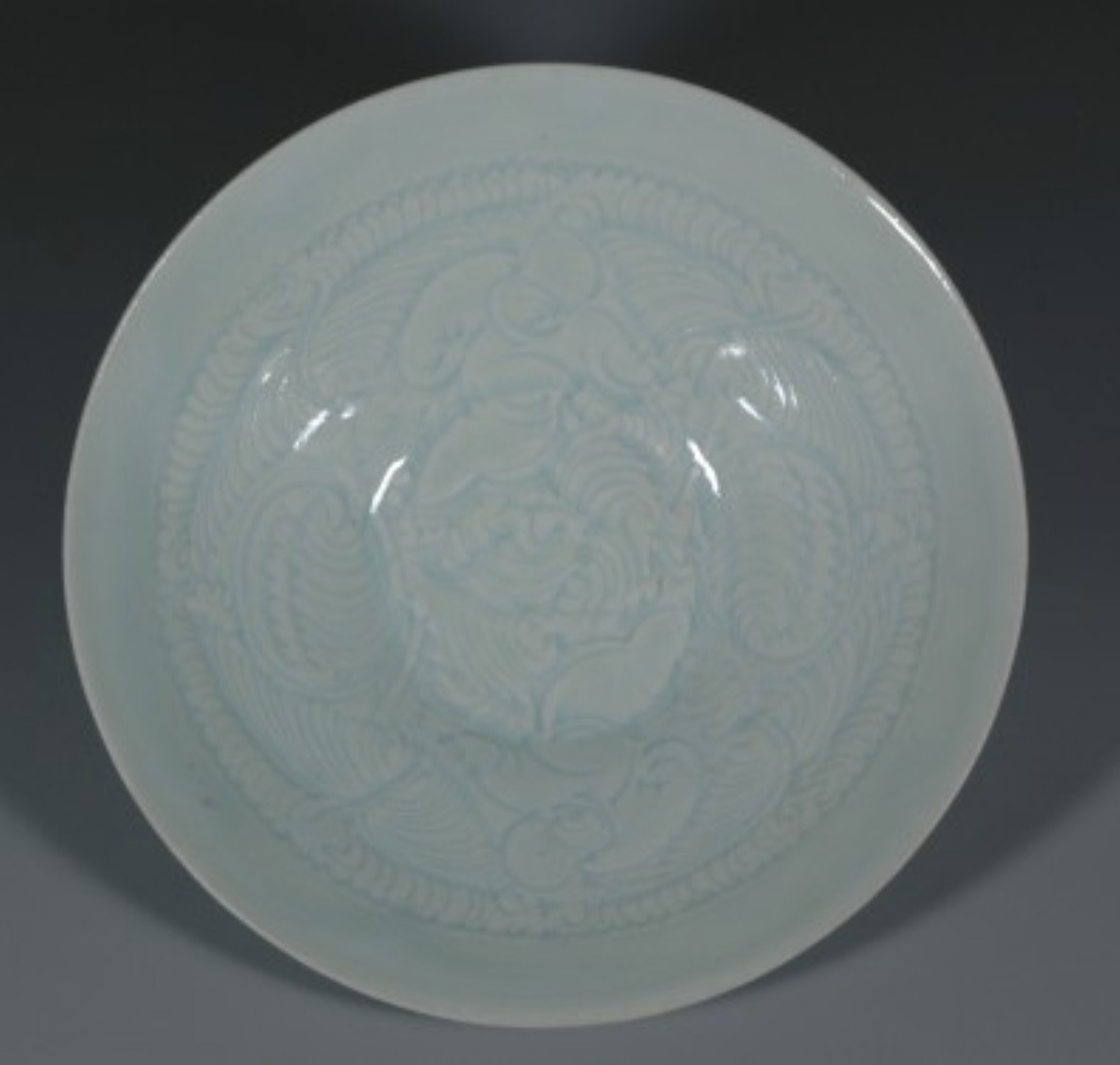
Qingbai porcelain bowl, Jingdezhen Kiln, Northern Song Dynasty, 5.5cm high and 19.8cm in diameter
This exhibition made the directors of the Tokiwayama Library realize that exhibitions and research cannot be achieved with their own collections alone. It is only meaningful to combine them with national collections such as Tobo. Gradually, the idea of entrusting the collection to be stored in the Tokyo National Museum came into being, and the collection of Tokiwayama Bunko may fill the gap in the collection of the Tokyo National Museum. In addition, after Japan's "Cultural Property Protection Act" was revised in 2018, the Tokiwayama Library building cannot publicly display collections, so most of the collections are entrusted and stored in the Tokyo National Museum, Kyushu National Museum, etc. These collections can be used for permanent exhibitions and special exhibitions. In order to give full play to the display and research value of the collection,
As a result, the 2019 exhibition "The Birth and Development of White Porcelain" selected from the collections of the Tokyo National Museum and the Tokiwayama Bunko Collection was born. The exhibition displays the high-temperature white porcelain that appeared in northern China from the Sui Dynasty to the early Tang Dynasty. It traces when and how Chinese white porcelain was developed. was born, and how it developed into the blue and white and multicolored porcelain that fascinates the world.
The "Beige Celadon Vase" that attracted much attention in the 2019 exhibition is also included in the exhibition. This porcelain originated from the official kiln of Hangzhou in the Southern Song Dynasty. Because of the yellow-brown color when fired with the oxidation flame, it is called "Beige". Celadon".

Beige celadon vase, official kiln, Southern Song Dynasty, height 21.6cm, base diameter 10.1cm
In Japan, this shape is called "Xiabu shape" and is modeled after ancient Chinese bronzes. Bronze and silver vessels of similar shapes were also unearthed from tombs in the Song Dynasty, which shows that this vessel shape was very popular in the Song Dynasty.
Although the bottle is imperfect in both shape and glaze color (the shape is somewhat distorted and the neck is tilted to one side), the light yellow-brown glaze covering the entire bottle has blue kiln changes on the trunk and bottom, indicating the firing process in the kiln. Medium oxidation has changed), but its beauty can still be felt. From a modern perspective, the most attractive part of this bottle is undoubtedly the ice cracks produced by the double penetration of the light yellow-brown glaze surface. At present, there are only 4 pieces in the world that have been recognized as "beige celadon", and three of them are in the Tokiwayama Library. Beige celadon is also one of the themes studied by the "Chinese Ceramics Research Society", and many of the ceramics in the exhibition have been published in the research society's journals.
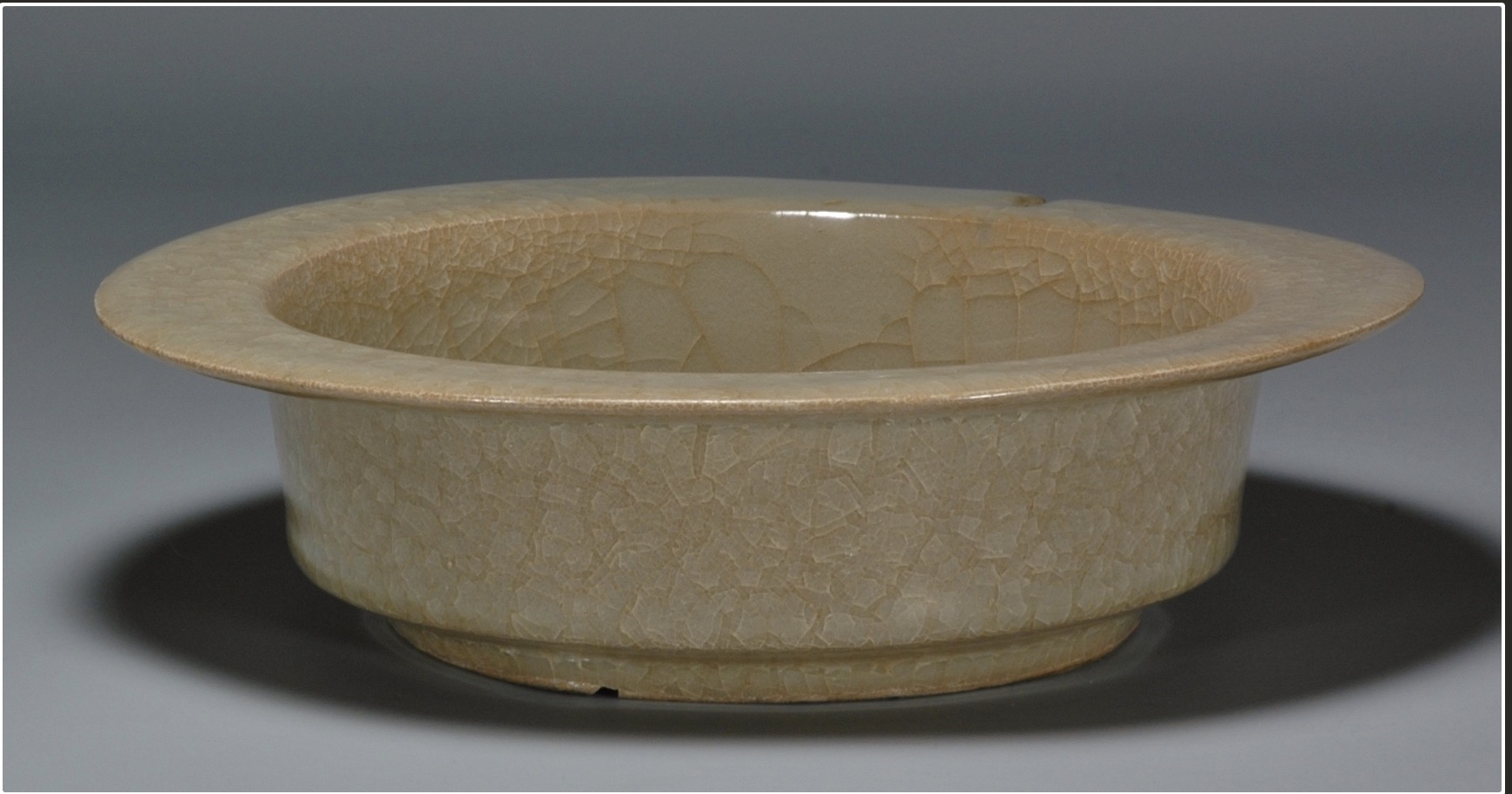
Beige celadon washer, official kiln, Southern Song Dynasty, height 5.4cm, diameter 19.7cm, base diameter 11.4cm, Southern Song Dynasty
Looking at Sino-Japanese cultural exchanges in the Song Dynasty from the perspective of Zen calligraphy and painting
In a display cabinet in the exhibition hall on the left, "Yi Yuanji Painting Scroll Postscript" by Feng Zizhen (1257-1315), a scholar of the Yuan Dynasty, is spread out flat. This is the postscript written by Feng Zizhen after the "Pictures of Flowers, Grasses and Insects" painted by Song Dynasty painter Yi Yuanji. Part of the painting is currently lost, but the postscript records his shock at the wonderful world of grass and insects described by Yi Yuanji.
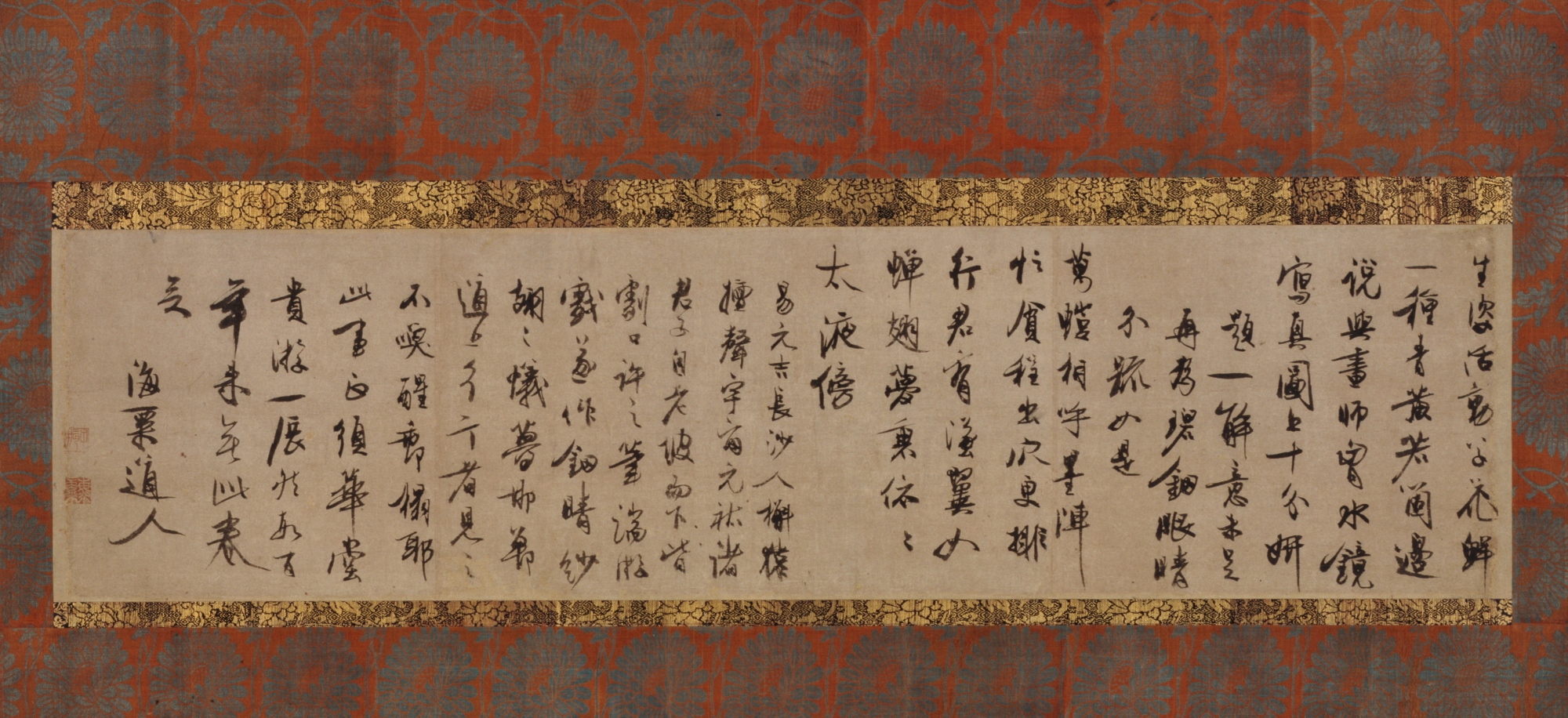
Feng Zizhen, "Postscript to the Scroll of Yi Yuanji", Yuan Dynasty of China (14th century), ink on paper, 30.0×118.4cm, Japanese national treasure, early exhibition
Sen no Rikyu once wrote to Yuan to praise Feng Zizhen's ink marks, and mentioned that "this is a good thing and should not be cut off." Due to the large length-to-width ratio of this inkblot, the collector may have considered cutting it off to fit the display, and Sen no Rikyu's advice is still followed today. Nowadays, Sen no Rikyu’s cover letter is placed in the same display case, allowing us to understand some of the stories of the inkjet’s history.
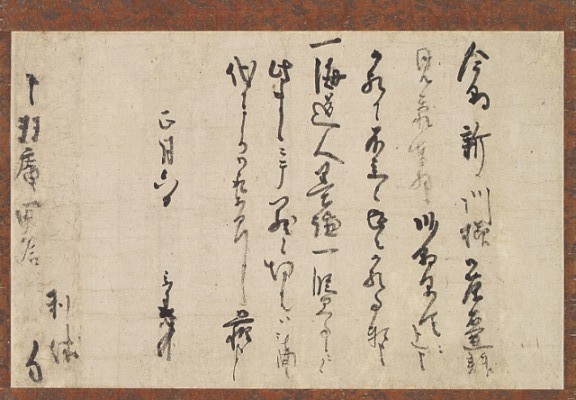
Sen no Rikyu’s cover letter
At the beginning of the exhibition, Master Wuzhun Shifu was mentioned in the Jianmen Miao Shen Shu and Sheng Yi Guoshi's official slips, and his ink marks are also reflected in the exhibition.
Wuzhun Shifan (1179-1249) was one of the most outstanding Zen monks in the Southern Song Dynasty. He served as the 34th abbot of Wanshou Temple in Jingshan, China, and served for 20 years. Many Japanese monks went to the Southern Song Dynasty to worship him as their teacher, among them Enji (also known as Shoichi Kokushi, 1202-1280), the founder of Tofukuji Temple in Kyoto, was one of them.

Wuzhun Normal School’s ink calligraphy on the Zen Temple plaque, Southern Song Dynasty (13th century), ink on paper, 71.7cm × 36.5cm, Important Cultural Property of Japan, early exhibit
It is for these reasons that Tofukuji Temple has many calligraphy treasures donated by Mujun Shifu, which are still well preserved today. In 1316, the Tofukuji document "Buddhist Zen Master Yubi Catalog" recorded 46 characters written by Wuzhun Shifan, indicating that these calligraphy were not only used in the temple in ancient times, but also passed on outside the temple. The red seal of "Pumon-in" stamped on the Mozhun Normal University ink in the Tokiwazan Bunko shows that this work was originally one of the treasures of Tofukuji Temple. According to research, "touring the hall" is a ritual for the temple to circumambulate various halls. This piece of calligraphy is probably a monk's hall plaque written for this purpose.
In the Song Dynasty, many Japanese monks went to China to study and visit Taoism. The Southern Song Dynasty literati Zhong Tangjie and Dou Congzhou's "Sending the Haidong Master Back to the Country" depicts a scene of a Japanese monk seeing off his friends when he returns home. The identity of this Japanese monk has not yet been determined, but some theories suggest that he may be Toshiyo (1166-1227), the Ritsu monk and founder of Senyong-ji Temple in Kyoto, or Chongyuan (1121-1206). This painting was created around the fifth year of Shaoxi in the Southern Song Dynasty (1194). Zhong Tangjie and Dou Congzhou had close contacts with Japanese monks. Both of them wrote the poem "Sending the Monk Back to Japan".
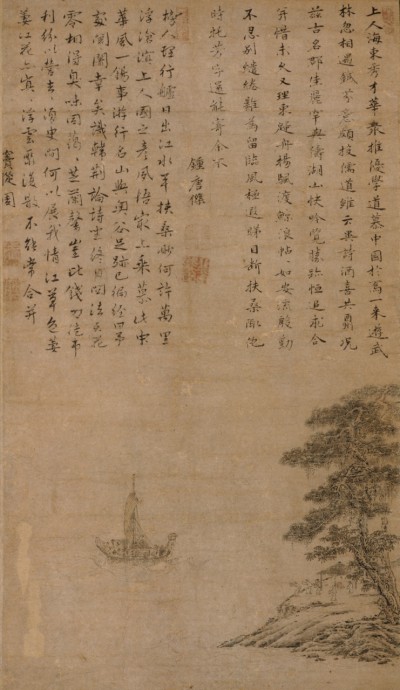
Zhong Tangjie, Dou Congzhou, "Sending the Haidong Master Back to the Country", the fifth year of Shaoxi in the Southern Song Dynasty (1194), light color on paper 63.6cm×36.3cm, important cultural property of Japan, later exhibits
This period happened to be the period when Zhu Zi's Confucianism and Zen Buddhism were officially introduced to Japan, so it is regarded as a very important work in the history of Chinese and Japanese art, Confucianism, and Buddhism.
The visual focus of the exhibition falls on the "Jasmine Picture" by Zhao Chang of the Southern Song Dynasty (biography). In the painting, a branch of jasmine has lush leaves and blooming flowers. The stems are outlined with a fine brush, and the leaves are smudged with different shades of green. The leaves stretch naturally, and there are many white petals with distinct layers, presenting the exquisite elegance of the style paintings of the Southern Song Dynasty. Many viewers who have seen the exhibition suggest that they appreciate this painting When working, use a monocular telescope.

(Biography) "Jasmine Picture" by Zhao Chang,
This exhibition is the first systematic display of the Tokiwayama Library’s collection of ink prints, paintings, and handicrafts in the past 20 years. On the occasion of its 80th anniversary, Tokipanyama Bunko will also cooperate with the Keio University Museum in October to hold the exhibition "Lying You-Zen Through Time and Space", exhibiting Zen ink paintings, guiding the audience to appreciate the works, free thinking and understanding work.
More works on display
Qing Zhuo Zheng Cheng, "Yi Gao (Ink Marks on the Coffin Cut)"

Seijo Masaki, "Relics (Ink Marks on the Coffin)", 1339, ink on paper, 36.6×92.4cm, Japanese national treasure, later exhibit
Qingzhuo Zhengcheng (1274-1339) was the younger brother of Yuejiang Zhengyin (1267-?), an eminent monk in the Yuan Dynasty. He became a monk at the age of fifteen and received ordination from Kaiyuan Temple in Fuzhou. In the first year of Jiali (1326), when he was 52 years old, he and his disciples Yongchi and others were invited to travel east to Japan. The founder of the Linji Sect of Zen Buddhism, the Dajian School, lived in Kencho-ji Temple, Jochi-ji Temple, and Enkaku-ji Temple, and then went to Kyoto at the invitation of Emperor Daigo to serve as the abbot of Nanzen-ji Temple and Kennin-ji Temple.
On the 10th day of the first lunar month in 1339, on the 17th day of the first lunar month, Qingzhuo realized that his life was about to end, so he wrote a verse for his disciples: "Kunlan is empty and the sea is standing, and the stars are wet for thirty-three days; Stones, fire and lightning cannot catch up." He passed away at the age of sixty-six. Legend has it that in the Zen Juan of Jianren Temple, there was a "niche cutting bed" specially prepared for this work.
Zhongfeng Ming edition, "Waiter Wan Jingce"
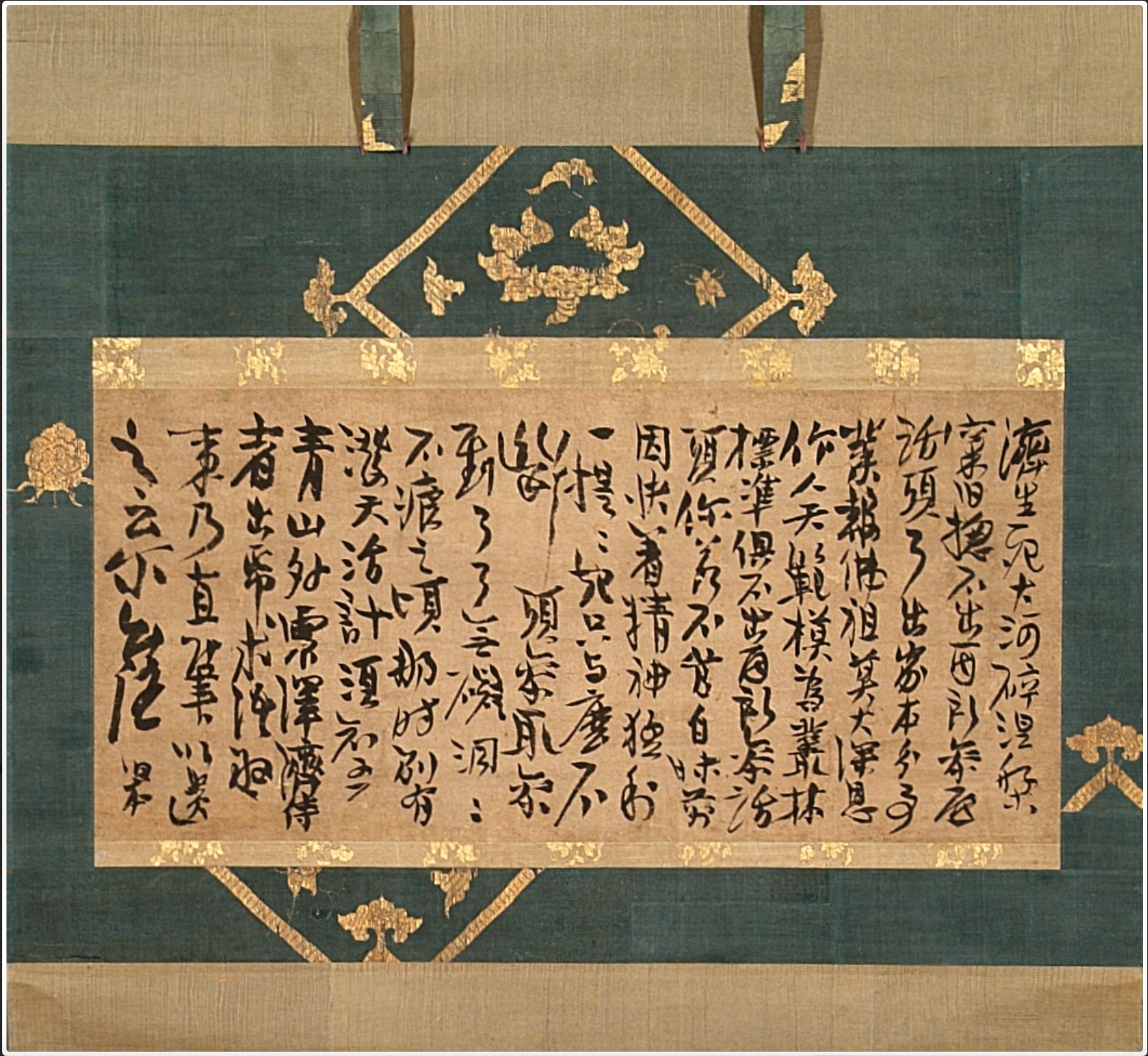
Zhongfeng Mingben, "Waiter Wan Jingce", Yuan Dynasty, 14th century, ink on paper, 31.5cm × 67.2cm, important cultural property of Japan, later exhibition
Zhongfeng Mingben (1263-1323) was a famous Zen monk in the Yuan Dynasty. He became a monk at Shengshui Temple in Wushan, and later went to Tianmu Mountain in Hangzhou to study Buddhism. He traveled all over the country. When the imperial court heard of his name, he was given the title of Zen Master Foci Yuanzhao Guanghui and summoned him to join the court, but he refused to go. They choose to live in a boat or a small nunnery and call themselves "phantom residence". The Ming Dynasty authored 30 volumes of "Zhongfeng Guanglu", which was included in the Buddhist collection. Mingben has extensive knowledge and famous poems, and has close contacts with Zhao Mengfu, Feng Zizhen, Guan Yunshi and others.
The Tianmushan Huantuan where he lived attracted many Japanese monks to visit. This calligraphy is a "warning policy" written to encourage a waiter named "済" who came from Japan to help him make progress in spiritual practice.
Zhongfeng's calligraphy style is very unique. Later generations used the sharp shape of the tip of the bamboo leaf as a metaphor, and it was described as "the peak of the bamboo leaf". In Japan, Somine Myosho (1282-1337, also known as Taideng Guoshi), is believed to have been inspired by Nakamine's style of calligraphy.
(Biography) Poems of Thirteen Monks, including Zhou Wen, E Kai Huiyu, etc.

(Biography) Poems of Thirteen Monks including Zhou Wen and E Kaihui, "Returning Home and Concerning Parents", Muromachi Period (15th century), light color on paper 83.9cm×25.7cm Important Cultural Property of Japan, early exhibits
This work includes the works of the painter E Kai Huishou and the poems written by thirteen monks. Hui Yu inscribed the inscription "Chu Rong sends people back home to visit relatives" on this painting.
The content of this work describes a monk returning home after practicing at Wushan Zen Temple in Kyoto, and his friends see him off. This farewell scene is represented in both poems and paintings, and is one of the few scrolls to contain the poems and paintings of "Farewell Picture".
Celadon Phoenix Ear Vase

Celadon vase with phoenix ears, Longquan Kiln, Southern Song-Yuan (13th century), height 27.5cm Late period
There are many vases with phoenix ears handed down from Japan, but each one is different in terms of overall slenderness and balance, the proportion of the neck to the torso, the tension of the shoulders, and the details of the phoenix ears.
This phoenix ear is very finely made, with clearly carved eyes, beak and crown, and the slender neck firmly supports the head, making the whole bottle look very tall and straight without being bulky. Also, unlike the others, this piece also has a unique feature of rounded shoulders. The words on the old box are embedded on the inner box cover, which reads "Flowers in the mouth of the blue vase". From the handwritten note attached to the back of the box cover, this box originally belonged to Kanemori Zonghe.
Carved lacquer moiré kettle

Carved lacquer teapot with cloud patterns, Southern Song Dynasty (12th-13th century), 28.5cm high
Carved lacquer, also known as lacquer carving, refers to a kind of carving technique specially used on lacquerware. It originated in ancient China and was highly valued by the Chinese royal family in the past. It is one of the most advanced arts and crafts. When making carved lacquer, the large lacquer should be applied repeatedly on the surface of the carcass of the utensils. After the lacquer layer has accumulated to a suitable thickness, the desired pattern should be picked out on the not yet completely solidified lacquer layer with a carving knife. Finally, it is finely polished according to the artistic effect pursued.
The carved cross-section of this lacquered moiré kettle shows a multi-layered effect. In the "Juntaiguan Left and Right Accounts", this technique is distinguished from the overlay of single-color lacquer and is called "rhinoceros skin". What's even more rare is that a kettle made with carved lacquer is extremely rare, and through X-rays, it has been confirmed that the bottom layer of this vessel is metal. The unique lacquer carving technique and rarity make this piece even more precious.
Note: This article is compiled from the websites of Tokyo Public Museum and Tokiwayama Bunko; the initial exhibition period of "Treasures of Tokiwayama Bunko" is from August 29th to September 24th; the later period is from September 26th to October 22nd.
